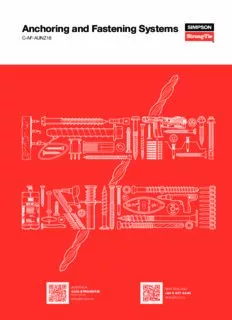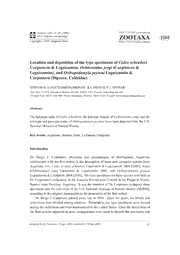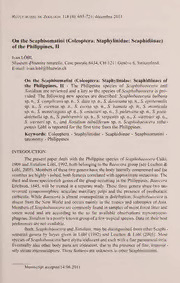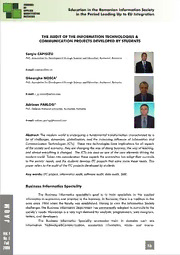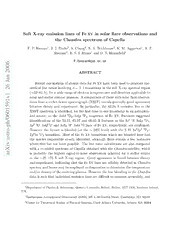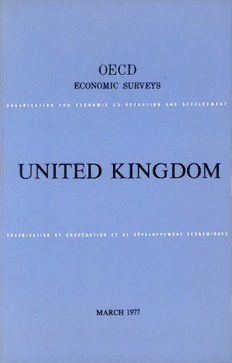
OECD Economic Surveys : United Kingdom 1977. PDF
Preview OECD Economic Surveys : United Kingdom 1977.
OECD ECONOMIC SURVEYS ;l :; ) | | s J i I 0 I ; U 3 ': K U I U 'I I H [. i.l H ;' r ;l \ I I I) I I Ml n r / : I H ;> I r I I UNITED KINGDOM \ | l :-: .\ i I H I il r i; 11 il ;' :' ;l A I I II I : I H : i] :' / : I i| ;' ;' : 'I : I I :' i: il I H 'I I i| II MARCH 1977 BASIC STATISTICS OF THE UNITED KINGDOM THE LAND Area (1000 sq. km) 244 Major cities (population in millions, Agricultural area (1 000 sq. km) 190 1975 mid-year estimates): Greater London 7.1 Birmingham 1.1 Glasgow 0.9 Liverpool 0.5 Manchester 0.5 THE PEOPLE Population (30.6.1975) 56043000 Total civilian employment, 1975 24632000 No. inhabitants per sq. km 230 of which: Net increase in population, Agriculture 667000 1971-75, annual average 75600 Industry (incl. construction) 10068000 Percentage change at annual Other activities 13897000 rates, 1975/1971 THE GOVERNMENT Public current expenditure 1975 Composition of House of Commons, (per cent of GNP) 24 November 1976 (No. of seats): Public sector current receipts 1975 Labour 312 (per cent of GNP) 46 Conservative 278 National debt 31st March 1976 Liberal 13 (ratio to General Government Scottish Nationalist 11 revenue) 155 Ulster Unionist 10 Other 11 635 Last general election: 10th Oct. 1974 FOREIGN TRADE Exports: Imports: Exports of goods and services as Imports of goods and services as a percentage of the GNP (1975) 28 a percentage of the GNP (1975) 30 Main exports (percentage of total Main imports (percentage of total exports in 1975): imports in 1975): Machinery 29 Petroleum and petroleum products Transport equipment 12 Machinery Chemicals 11 Chemicals Textiles 4 Non-ferrous metals Non-ferrous metals 3 Fruit and vegetables Iron and steel 3 Meat THE CURRENCY Monetary unit: Pound sterling Currency unit per US %, average of daily figures: Year 1976 0.5567 February 1977 0.5846 Note An international comparison of certain basic statistics is given in an annex table. OECD ECONOMIC SURVEYS UNITED KINGDOM ORGANISATION FOR ECONOMIC CO-OPERATION AND DEVELOPMENT The Organisation for Economic Co-operation and Devel¬ opment (OECD) wassetupunderaConventionsignedin Parison 14th December, i960, which provides that the OECD shall pro¬ mote policies designed: to achieve the highest sustainable economic growth and employment and a rising standard ofliving in Member countries, while maintaining financial stability, and thus to contributetothedevelopment ofthcworld economy; to contribute to sound economic expansion in Member as well as non-member countries in the process ofeconomic development; to contribute to the expansion ofworld trade on a multi¬ lateral, non-discriminatory basis in accordance with inter¬ national obligations. TheMembersofOECDarcAustralia,Austria,Belgium,Cana¬ da, Denmark, Finland, France, theFederal Republic ofGermany, Greece, Iceland, Ireland, Italy,Japan, Luxembourg, the Nether¬ lands, New Zealand, Norway, Portugal, Spain, Sweden, Switzer¬ land, Turkey, the United Kingdom and the United States. The Socialist Federal Republic ofYugoslavia is associated in certainworkofthe OECD, particularlythat ofthe Economic and DevelopmentReview Committee. The annual review of the United Kingdom by the OECD Economic and Development Review Committee took place on 24th February, 1977. © OECD, 1977. Queries concerning permissions or translation rights should be addressed to: Director ofInformation, OECD 2. rueAndré-Pascal, 75775 PARIS CEDEX 16, France. TABLE OF CONTENTS Introduction I Recent developments 5 Inflation 5 Demand and output 7 The labour market 10 The external situation ]1 II Economic policies 17 Budgetary policy 17 Monetary policy 22 Income and price policies 26 Industrial and employment policies 27 III The outlook for 1977 28 IV Medium-term prospects and policies 31 Medium-run policies 31 The oil sector 34 The options open 36 A simple scenario 37 Some policy issues 39 V Conclusions 41 Annexes I Short-run monetary management and the exchange rate 43 II The economic impact of North Sea oil 49 III Calendar of main economic events 52 Statistical annex 63 TABLES Text: 1 Cost and price indicators 6 2 Contribution to consumer price increases 7 3 Expenditure and output 8 4 Balance of payments 1 1 5 Public sector revenue and expenditure 19 6 Public sector and general government deficit and borrowing 19 OECD Economic Surveys 7 Monetary indicators 24 8 Demand and output in 1977 29 9 The balance of payments impact of North Sea oil 35 10 A medium-term growth scenario 38 Statistical Annex: A Expenditure on GDP 63 B Consumption and investment 64 C Production and manpower 65 D Domestic finance 66 E Wages, prices and external position 67 F Analysis of total currency flow and official financing 68 DIAGRAMS 1 Stock changes and stock ratios 9 2 Labour market indicators 10 3 External trade 12 4 Sterling balances and exchange rate 16 5 Effective tax rates on earned income 18 6 Public expenditure programmes 21 7 Interest rates and monetary aggregates 23 8 Investment in manufacturing 33 INTRODUCTION Economie developments between 1975 and 1976 followed quite closely the Secretariat's forecasts made a year ago. Final domestic demand declined marginally, output growth was small, inflation remained in the 15 per cent range, the current external deficit was close to $3 billion, and unemployment increased further. But while early last year this overall pessimistic projection was tempered by the expectation that growth and price performance would improve through 1976, an ex-post assessment indicates that the opposite occurred. After a promising start in early 1976, the situation deteriorated markedly from the spring onwards, and the second half of the year saw decelerating growth, accelerating inflation and a growing foreign deficit. The two successive runs on the pound were both a symptom of the economy's fragility and a cause of some of its difficulties. Faced with such developments, economic policy, following an earlier period of hesitation during which conditions in the domestic money market were allowed to ease, was tightened progressively from spring onwards. Three succes¬ sive packages of short and medium-run public expenditure cuts were announced and the late months of the year saw an unprecedented monetary squeeze. Early 1977 has witnessed some improvement in a number of indicators and a clear regain of confidence in the economy. But even if the external situation may at present give less reason for concern, the short-term outlook is still for relatively modest progress in re-establishing internal balance. In addition to the review of recent trends (Part 1), economic policy (Part II) and the short-term economic outlook (Part III), the present draft Survey includes a discussion of medium-term policies and prospects (Part IV) prospects which could well be more promising than generally expected, provided the economy surmounts the present inflation problem. Some concluding comments are offered in Part V. I RECENT DEVELOPMENTS Inflation The underlying inflation rate (retail prices excluding food), after the sharp deceleration during the six months to end-1975, remained relatively stable at an annual rate of about 13 to 15 per cent through 1976. Two major forces have been pulling in opposite directions. On the one hand, since the introduction of the new pay policy in August 1975, the slowdown in average earnings combined with some recovery in output have resulted in a strung deceleration in unit labour costs to an annual rate of about 10 per cent compared with 36 per cent in the year to mid-1975. On the other hand, the rise in import prices accelerated markedly in the second quarter of 1976 and remained at a high level during the rest of the year, largely because of the substantial effective depreciation of sterling since March 1976 though sharp rises in certain international commodity prices also played a role. Moreover, certain increases in indirect taxes added a little less than 1 per cent to consumer prices. The growth in food prices was OECD Economic Survexs Table 1 Cost and price Indicators Percentage changes at annual rates From From previous year Frohmalfpyreevairous previous quarter 1974 1975 1976 1975 1976 1976 11 I II Q3 Q4 Seasonally adjusted GDP (factor cost) deflator 15} 28} 233 9} 17 Unit labour costs' 21} 32} 23 8} 83 Basic weekly wage rates' 171 30 191 28} 223 10} 11} 23 Average earnings' 171 263 15.5 25 123 121 133 11} Gross trading profits of companies net of stock appreciation (£ billion, annual rate) (5S) (64) (63) (71) (7) Indirect taxes net of subsidies per unit of output -33 23} 57} 163 22} Consumers' expenditure deflator 16 23 1534 24 12} 143* 15 181* Not seasonnally adjusted Retail prices: Total 16 241 16} 23 151 13} 9} 19} Food 18 25} 20 19 23 154 5 40 Non-food 15} 233 15} 24} 13 123 103 14 Wholesale prices Output5 23} 24 16} 17} 151 173 17} 203 Input' 49 9} 27 23 27} 293 21 333 Import prices' 56 123 22} 11 23} 29} 231 33 1 The change of the ratio of income from employment to GDP at factor cost, on a "compromise" basis, 2 Manual workers only, not seasonally adjusted. 3 Industries and services covering about 7 million employees in production industries, transport and communication and certain miscellaneous services. 4 OECD estimate for the fourth quarter. 5 Home sales, all manufactured products. 6 Basic materials and fuels purchasedby manufacturing industry. 7 Balance of payments basis, goods only. Sources: Monthly Digest of Statistics; Economic Trends; Department o] Employment Gazette. higher (some 20 per cent between 1975 and 1976) and accelerated in the course of the year reaching some 40 per cent, at an annual rate, in the fourth quarter; the effects of the drought in the summer, substantial tropical food price increases, and large cuts in food subsidies all contributed in pushing up food prices. The latter's rise would, moreover, have been considerably larger had the "green pound"1 devalued in line with the devaluation of sterling. In total retail prices rose by over 16 per cent between 1975 and 19762. On the cost side, the £6 a week voluntary incomes policy introduced in August 1975 for one year had a considerable impact on pay trends. Since almost all pay settlements were broadly within the limits set by the agreement, the annual growth of average earnings decelerated markedly to roughly 14 per cent during the twelve months"to July 1976, compared with 28 per cent over the previous twelve months. The new pay policy introduced in August 1976 (for 1 The "Green Pound" expresses the exchange rate used for imports of food products under the European Community's Common Agricultural Policy. It is officially estimated that a devaluation of the green pound to take full account of the devaluation of sterling would have added some 10 per cent to the food component of the consumer price index. 2 The increase in the national accounts consumption deflator was roughly 1 per cent smaller. United Kingdom Table 2 Contribution to consumer price increases Percentage changes, seasonally adjusted at annual rates From previous From previous year half year 1973 1974 1975 1976? 1975 1976 11 I IP Income from employment per unit of output 3.6 7.0 11.6 4.8 9.2 3.8 3.2 Other cost per unit of output3 4.1 3.1 3.7 3.2 6.8 1.8 3.1 Taxes less subsidies per unit of output 0.1 -0.6 3.6 4.5 9.2 2.8 3.3 Price of imports of goods and services3 3.3 8.6 3.5 3.7 2.6 3.7 4.8 Residual -2.6 -2.0 0.7 -0.5 -3.8 0.3 0.3 Consumers' expenditure deflator* 8.5 16.1 23.1 15.7 24.0 12.4 14.7 1 Based on actual data up to third quarter fourth quarter figures arc OECD estimates. 2 Total domestic income less income from employment, thus including gross trading profits of companies, gross profits of other public enterprises, gross trading surplus of public corporations and income from rent and self-employment. 3 Implicitnational accountsdeflator ofimports ofgoods andservices. 4 Implicit national accounts deflator ofconsumers* expenditure. Note The weights used in calculating the contribution of the primary input costs to the consumer price deflator were taken from the summary 1972 input-output tables and the impact of wage costs and import prices was assumed to be lagged with an average lag of 0.8 quarters. The varying importance of the residual item may reflect in part variations in both the weights and lags. Source: Economic Trends and OECD estimates. details see Part II) appears to have also been observed and the ensuing growth of average earnings between July and December 1976 was around 5i per cent3, against an expected increase in the twelve months to July 1977 of some 8 to 9 per cent. Under both phases of the pay policy, average earnings have been increasing somewhat faster than the proposed basic pay increases, largely reflect¬ ing increases in overtime, shift premiums and related payments accompanying the modest output recovery from the low level in the third quarter of 1975. In addition, the recovery may have facilitated regrading and other practices which increase average earnings without strictly speaking infringing the agreed basic pay norms. The index of basic weekly wage rates shows a much stronger growth than average earnings during 1976 suggesting that minimum wage rates have increased faster than the average, entailing some narrowing of pay differentials. Company profits recovered somewhat in 1976, but through the year they appear to have remained roughly flat at about the level reached at the end of 1975. While profit margins on exports have probably risen, sluggish domestic demand appears to have been largely responsible for the flat overall trend. Income from self-employment and from rent continued to rise at a moderate but steady pace. Demand and output With consumer prices increasing relatively rapidly and the rise in nominal incomes constrained by the pay policy and the overall sluggish demand situation, real disposable income fell in 1976 for the second year in succession, probably by some 1 per cent. Nonetheless, private consumption rose marginally because of a reduction of about li per cent in the personal savings' ratio. This decline, the first since 1971, must have been primarily due to the 1975-1976 squeeze on real incomes. In addition, the increasing share of personal income accounted 3 Largely due to some bunching in wage settlements in the fourth quarter of 1976 and also because of certain late pay increases made under the earlier £6 a week policy the rise in average earnings between mid and end-1976 overstates the underlying trend growth of earnings. OECD Economic Surveys Table 3 Expenditure and output Percentage volume change, seasonally adjusted at annual rates From previous year From previous half year 1973 1974 1975 1976» 1976 I IP Private consumption 4} -1 -3 4 13 2} Government consumption 4} 2 43 23 2 1 Fixed investment 4 -2 -1} -4 -8 1 Final domestic demand 41 -i 3 } (cid:9) 14 Plus change in stockbuilding* 2 -1 -2} 1 1} 4 Plus compromise adjustment'" -1 -i -} -4 4 Total domestic demand 6} -2 -2} 11 H 3 Exports 12 7 -33 64 12 74 Imports 13} 4 -6} 53 4} 104 Change in foreign balance1 - 14 4 1 2 -4 GDP at market prices* 6 -i -13 14 3} 2 Agricultural production 23 4} -6 -61 3 -24 Industrial production 7} -3} -5 1 4 -4 of which: Manufacturing 8} -24 -6} 14 5} 2 Services 23 13 13 1 13 3 GDP at factor cost on an output basis 5} -3 -2} 1 3} 14 1 1976 is provisional as it is based on published data for the first three quarters and on OECD estimates for the last quarter. 2 As a percentage of GDP in the previous period. 3 The difference between expenditure based output and "compromise" output. The latter is the weighted average of the output,,expenditure and income measures of GDP. The weights are respectively 40 per cent, 40 per cent and 20 per cent. 4 On a "compromise" basis. Sources:Economic Trends; "Press and Information Service Release" and OECDestimates. for by social security payments, out of which the marginal propensity to save is relatively low, slower inflation, and the marked turnaround in demand for passenger cars from a fall of 5 per cent in 1975 to a rise of 7 per cent in 1976 were probably further contributory factors. In the public sector, the growth of consumption decelerated markedly in line with the April budget. While public sector investment probably remained roughly flat in 1976, private fixed investment fell appreciably following smaller declines in the two previous years. Investment in the manufacturing, distribution and services sector was influenced by depressed demand conditions in 1975 and the tight overall financial situation of industrial and commercial companies which continued until early 1976. The year-on-year decline conceals, however, an important change in trend during 1976. The steep downward trend came to an end in the first quarter of 1976; during the remainder of the year there was a moderate rise. This reflected a lagged response to the growth of output, some recovery in business confidence associated with improved export prospects, and an improved financial and profit situation. Residential construction showed a moderate increase in the first three quarters of the year thanks to the improved liquidity position of building societies and a small fall in mortgage rates between April and September. But the sharp rise in such rates in October, following the imposition of severe monetary restrictions, has probably led to a decline which may have roughly offset the rise recorded until then. Despite the improved financial situation of the company sector and the large decline in stockbuilding the previous year, 1976 saw some further inventory decumulation which probably affected all levels of production and distribution. Early in 1976 stock/output ratios were still high compared with past trends,
The list of books you might like

What Happened to You?

Mind Management, Not Time Management

Better Than the Movies

The Spanish Love Deception

Infinite ergodic index of the ehrenfest wind-tree model

An Introduction to Fully Integrated Mixed Methods Research

Boletín Oficial de la República Argentina. 2007 2da sección

The Annotated Big Sleep

Gluten-Free Bread
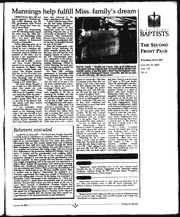
The Baptist Record Jan. 25. 2007

Individual Differences in Computer Assisted Language Learning Research

Ken Schultz's field guide to saltwater fish

DTIC ADA442146: Performance of Polymer-Encased Concrete Walls Subjected to Blast Loads

Demographic & economic information for Yellowstone County
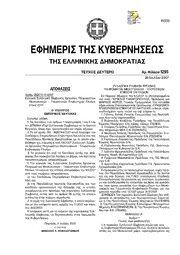
Greek Government Gazette: Part 2, 2007 no. 1295

Экологический практикум. 5(6) класс

Elements of Music (Wooden Books Gift Book)

Rcc

Medicinal Research Reviews 1993: Vol 13 Index
